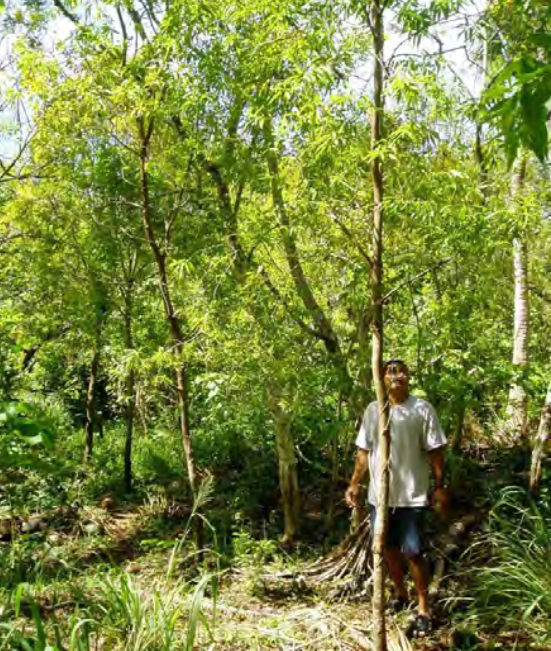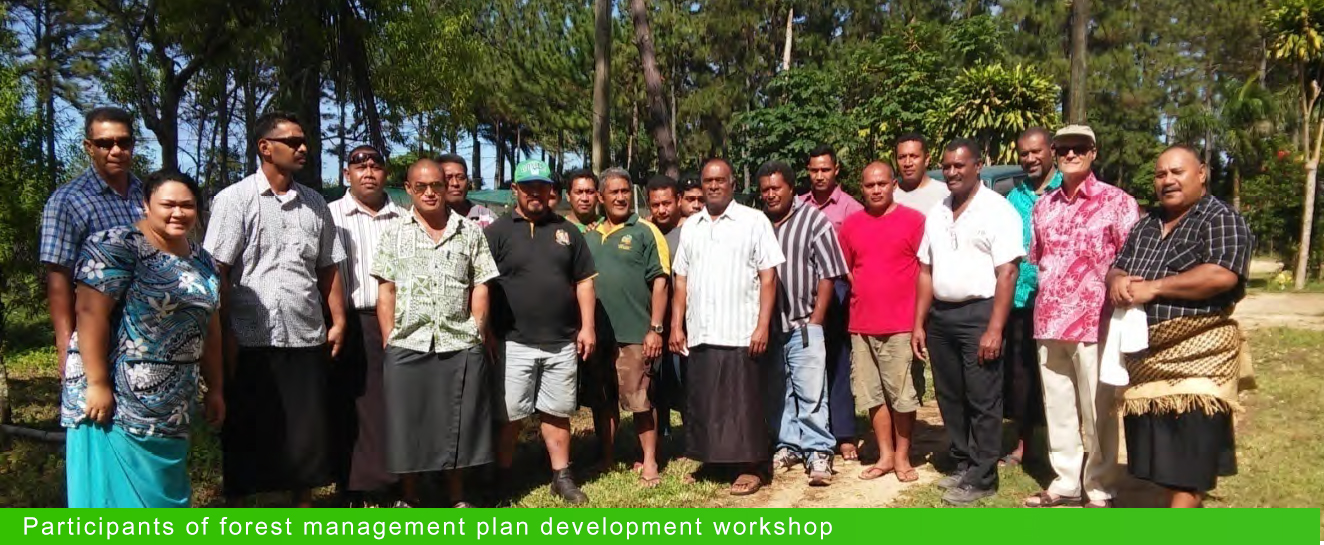Capacity building towards effective implementation of SFM practices in Fiji, Tonga and Niue
Project title: Building capacity to effectively implement sustainable forest management practices in Fiji, Niue and Tonga [Project ID: 2015P3-SPC]
Executing agency: Secretariat of the Pacific Community
Implementing agency: Forestry Divisions within the Governments of Fiji, Niue and the Kingdom of Tonga
Budget in USD (total/APFNet grant): 666,500/488,500
Start date & duration: June 2015, March 2016–March 2019
Target economy: Fiji, Niue and Tonga
Location: Forests and tree resources of Fiji, Niue and Tonga
Objectives: Develop a forest management plan (FMP) for Tonga and complete the FMP for Niue; Develop strategies and mechanisms for effective implementation of FMPs and codes of forest practices in Fiji, Niue and Tonga; Develop mechanisms for monitoring and reporting on implementation of FMPs and codes of forest practices in Fiji, Niue and Tonga .
Expected outputs: Background report to review the current status of forests and forest management in Tonga and highlight issues that are relevant for consideration under a FMP of Tonga; Completed FMPs for Niue and Tonga; Background reports to review the current legal and policy framework, institutional arrangements and mechanisms for implementing FMPs and codes of practices in the economies of Fiji, Niue and Tonga; Development and submission of implementation strategies for governmental approval; Development of training and education packages to promote implementation of FMPs and codes of practices; Enforcement strategies are in place; Institutional arrangements are in place to monitor the implementation of FMPs and codes of practices; Development of monitoring and reporting protocols.
Project background
Forests and tree resources are an integral part of land use in the Pacific Island economies, including Fiji, Niue and Tonga. Covering small areas across dozens of islands, forests and trees provide timber, food, medicine and other products and are a key source of income to communities and landowners. They also play a critical function in coastal and storm protection, and mitigate the effects of climate change to vulnerable islands. However, these resources have been depleted through agricultural land clearing and unsustainable harvesting practices. Often, the small size of the economies means there is a lack of funds to invest in better forest management and monitoring. Hence, the adoption and implementation of effective and practical regulatory frameworks for sustainable forest management, along with targeted capacity building, has the potential to substantially improve the environmental, social and economic benefits that forests and trees can bring to landowners and communities. APFNet funded the project “Building capacity to effectively implement sustainable forest management practices in Fiji, Niue and Tonga” to: 1) support and assist the economies to develop sustainable forest management plans; and 2) build a mechanism for the effective implementation, enforcement and monitoring of forest management plans and codes.
Table 1. Review of regulatory frameworks and priorities for improvement in Fiji, Niue and Tonga
|
Economies |
Forest management plan (FMP) |
Code of practice (CoP) |
Implementation strategy (IS) |
Priorities |
|
Fiji |
Yes |
Yes |
No |
To develop effective strategies to implement the CoP.
To develop IS and mechanism for monitoring the IS. |
|
Tonga |
No |
Yes |
No |
To develop a FMP.
To develop IS and mechanism for monitoring the IS. |
|
Niue |
Yes, draft version only |
Yes |
No |
To finalize the FMP.
To develop IS and mechanism for monitoring the IS. |
Strategically planning the sustainable management of forests
♦ Tonga
Tonga is a big island and 85 percent of the land is covered with forests in the form of agroforestry, coconut woodlands, timber plantations, and remnant natural forests. Nearly half of all forests are in private ownership and face threats such as clearing for agriculture, unsustainable cutting of sandalwood, land tenure conflicts and a lack of local knowledge on conservation. Although national policies exist, such as the National Forestry Policy (2009) and the Code of Practice for the Sustainable Management of the Forests and Tree Resources of Tonga (2010), Tonga needed a clear forest management plan. APFNet supported Tonga in the development of a plan, which was adopted in April 2017 by the government. The plan outlines strategic actions and methods to tackle threats to forests and stipulates institutional arrangements to enable successful forest management. A large part of the plan focused on the sustainable management of sandalwood, one of the highest value forest commodities. Sandalwood has potential to make a substantial, ongoing socioeconomic contribution to landowners and local communities. The Operating Procedures for the Sandalwood Trade for Tonga has been adopted by the government to promote sandalwood planting, control theft, and achieve sustainable management of the resource.

Figure 1. Sandalwood sapling in secondary growth forest on Ha’apai, one of the main island groups in Tonga.
♦ Niue
Located to the west of Tonga, Niue faces similar issues to Tonga. The National Forest Policy Statement (2003), Code of Harvesting Practice (2004) and a draft national forest management plan (2013) already existed. The project supported Niue to circulate the draft management plan for final consultation among stakeholders and submit the plan for approval by the government. The plan focuses on training and education for stakeholders, responsible self-regulation by landowners, transparent monitoring and reporting, and government commitment to ensure the forests are managed on a sustainable basis.
Implementing plans
Once forest management plans and codes of practice are in place, mechanisms for implementing these frameworks are needed. The project developed these mechanisms for Fiji, Niue and Tonga through consultation with government agencies and stakeholders. Following the proposal of a number of models, the enhanced co-regulatory model was chosen for implementing policy and regulatory frameworks in all three economies. This model mainly focuses on building capacity for self-management and self-regulation within the private sector (industry, timber licensees, landowners, etc.) whilst the government focuses on core functions. Specifically, the private sector has the authority and responsibility to plan, approve and certify, monitor and report on their timber harvesting operations while the government will periodically assess the quality of private sector reporting and monitoring; ensure enforcement of legislation and codes of practice, while also provide training and education for landholders, community groups and other relevant stakeholders.
However, the strategies and plans for effective implementation of policies and regulatory frameworks are different among the three economies. In Tonga, the strategies and implementation plans are included in the forest management plan and have already been approved and launched by the government. They focus on key aspects of improving the legal and policy framework, building capacity for enhanced co-regulation, and improving the enforcement of forest laws through monitoring and reporting on sustainable management. Niue has developed draft government strategies such as establishing a register of potential timber production lands, attracting businesses for harvesting and processing of timber, building capacity of forest owners and other relevant stakeholders on the effective implementation, enforcement, monitoring and reporting of the forest management plan. Fiji primarily needs support in the effective implementation of the existing Forest Harvesting Code of Practice. The implementation of the Code follows the co-regulatory model (described above), which appoints forest practice officers within the industry to be authorized to certify harvest plans, monitor and enforce the Code, and provide compliance reports to the Forest Department. An independent monitoring unit will verify and report on the quality of implementation. To improve effective implementation, 21 actions have been identified and discussed among government and other stakeholders for strengthening the regulatory framework of the Code. After finalization, implementation strategies will be submitted to the government for approval.

